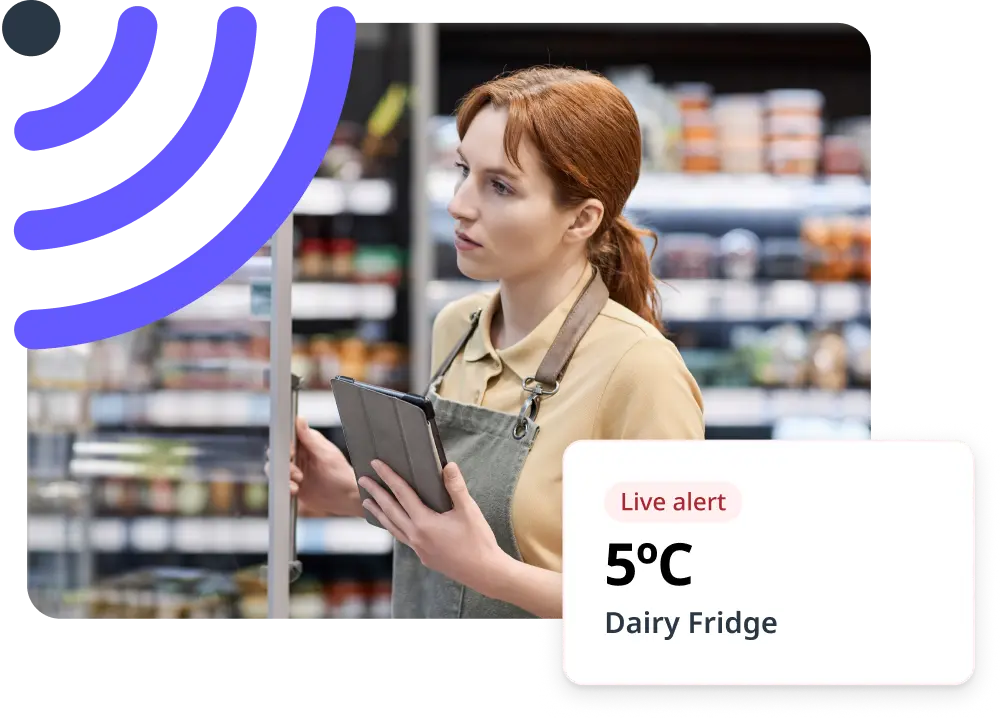Easy to get started
Our self-installation guide makes it easy for you to install the hardware and setup simple reporting and alerting via mobile – without having to pay for professional services.
Automate records of data readings, set critical alerts for out-of-range temperatures, and ensure that hot and cold foods stay in optimal condition to keep food safe for consumption.

Improve hot and cold temperature readings with SafetyCulture Sensors. Our temperature loggers enable you to closely monitor and maintain ideal temperature and humidity conditions throughout the entire food storage and transportation process of perishable goods. Experience peace of mind knowing your products are monitored in real-time and take action when necessary.
Let us know what you have so we can help integrate them with our platform
Learn how top industries can maximize temperature-logging devices
A hot & cold temperature logger is a software or program designed to record temperature readings for food or food products in hot & cold holding. It is an essential asset for businesses in the food industry as they need to ensure that food is kept in optimal hot or cold temperatures to prevent pathogen growth and keep them safe for consumption.
Temperature data loggers are commonly used in industries and applications where temperature control and monitoring are critical. They are utilized for temperature monitoring, quality control, identification of hot and cold temperature-related issues, providing valuable data for analysis and decision-making, compliance with regulatory requirements, and the capability of remote monitoring. Ultimately, the goal and main benefit of devices such as this is an enhanced operation for the organizations employing them.
Some data loggers have an accuracy percentage of 1-2%, while high-accuracy specialized units are at 0.01% on the full-scale range. The level of accuracy is heavily dependent on factors such as the manufacturer’s specifications, sensor quality, frequency of calibration, environmental factors, and the actual placement and usage of the devices.
By using a data logger, you gain access to reliable, accurate, and continuous data that you can leverage for better decision-making. The ability to remotely monitor conditions and analyze the collected data also provides valuable insights and empowers you to proactively address issues, resolve problems before they disrupt business operations, and improve the overall efficiency of your monitoring process.
Some of the key aspects and capabilities to consider when deciding which temperature loggers to choose are temperature range, accuracy and resolution, sensor type, data storage and retrieval, interface and connectivity, durability and environmental conditions, budget and cost, and software compatibility. By prioritizing what’s critical for your business, you’ll be able to determine which one caters to your specific needs.
Although there’s no specific frequency that applies to all types of data-logging sensors, it is generally recommended to calibrate them at least once a year. The actual interval would depend on factors such as the manufacturer’s recommendations, industry regulations, and audit requirements, among others.
Once you’ve connected your sensors or local weather data to SafetyCulture, you can continuously monitor and maintain your conditions without lifting a finger. Tell us what range conditions need to stay in, and we’ll alert you any time that they go outside this range. From there, you can quickly set up a corrective action within SafetyCulture, assign it to the right person, and keep track of it until it’s closed. You’ll also have a complete historical log of data, in case you ever need to check that conditions were met during a certain period, or want to track trends in your conditions.
Both devices have an operating range of -40C to +80C (-40F to +176F). If you are monitoring outside these temperatures, the standard fridge and freezer sensor has the option for an additional probe which will boost the operating range to -55C to +125C (-67F to +257F). Outside of these temperatures, we would not recommend deploying these devices, please contact us to discuss your use case in more detail.
Yes, all your data is stored from the moment you start taking readings. This data is easily downloaded as a csv to be shared with third-parties, regulators or internal stakeholders
Only if you want them to. As the admin, you can control which sensors get added, what alerts are set up, and who else can make these changes.
We’re working hard to support as many types of sensors as possible! We want to make the most of any data that is important to you. If you’ve already got an internet-connected sensor solution installed and want to bring the data into SafetyCulture, let’s have a chat. No promises, but we’ll do our best to make it happen.
It depends. If you’ve already got sensors and you just want the data to feed into SafetyCulture, then there’s no added cost! We only charge for any hardware that you buy directly from us, and the ongoing costs associated with running them. See our SafetyCulture sensors page to learn more about the hardware solutions we offer.
Learn more about other Food Safety Monitoring Systems